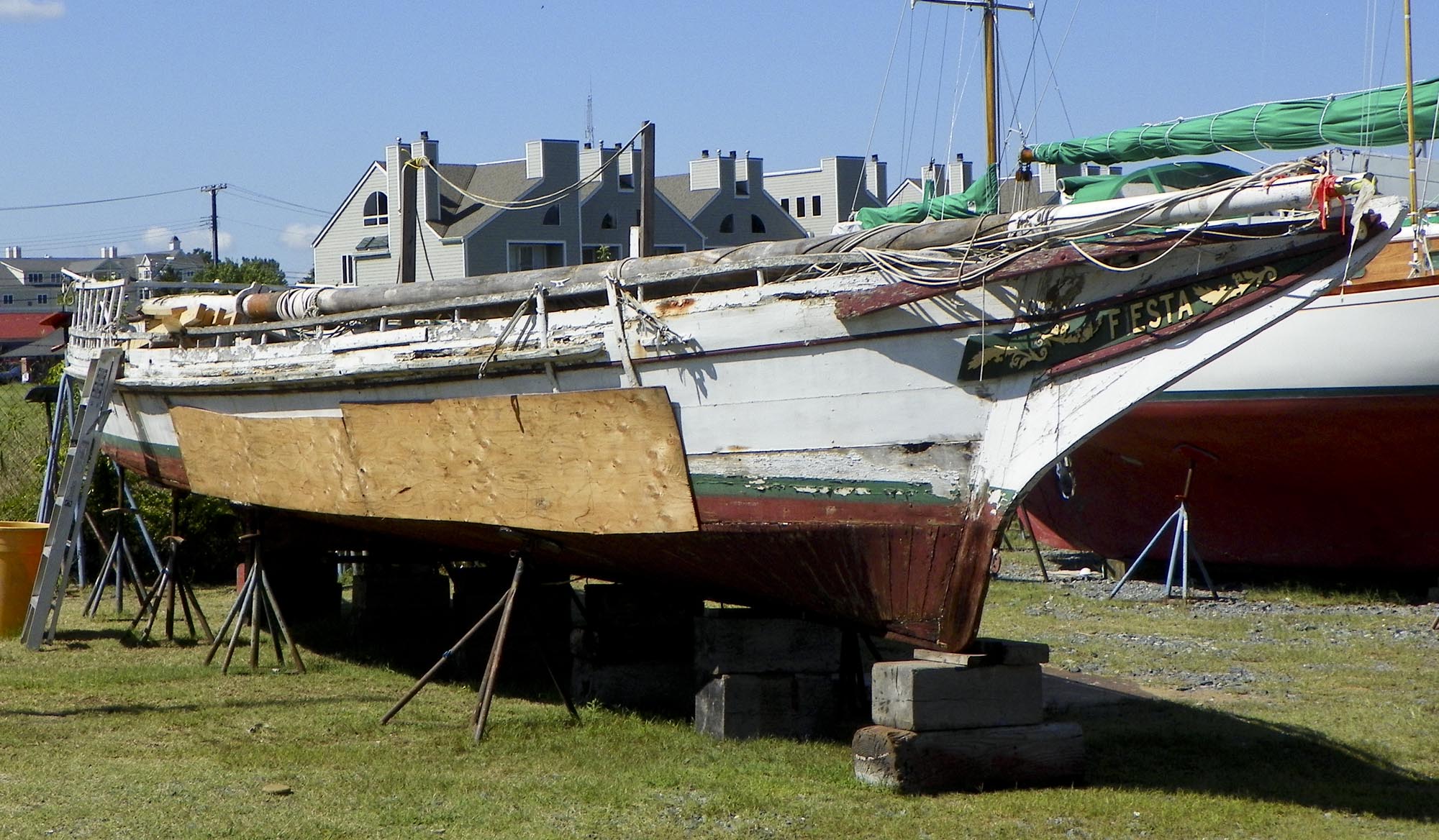Fiesta (Three-Sail Bateau)
Status
Lost circa 2018


Lost circa 2018

Fiesta was a three-sail bateau built by James B. "Mr. Jim" Richardson in Cambridge, Maryland, in 1957. Stan Davis provided the following account of her creation:
The Fiesta project actually began circa 1955. Jim Richardson, like so many skipjack builders, designed mainly by half models and 'rack of eye.' Jim rarely used plans or engineering drawings, etc., to create his boats, but Fiesta is an exception. She was a one-off special job for a customer with some very particular requirements, requirements that would not have been answered by any of Jim's models to date.
Jim was concerned about what specific changes to his normal bateau would be required and how the boat would look when finished. He asked my father, Cambridge boat designer and artist Owen Davis, to give him some ideas. Jim and my father were particular friends, and my mother, Margaret Richardson Davis, and Jim were distant cousins. So Owen became involved in the project to figure out how these special requirements could be met in a 30-some-foot hull.
Basically, the customer wanted standing headroom throughout the cabin, plenty of light and air below, lots of storage in the cockpit/near the helm, and a spacious engine room (plenty of room to work on the 'mill.') Owen drew up a set of plans for Jim to use, which unfortunately have been lost. The resultant boat was beamier and characterized by greater than normal freeboard in order to provide super-spacious accommodations below despite her relatively short LOA.
Owen was a graduate of what is now called UARTS, an industrial design school created to support the 1876 Centennial International Exhibition, the first official World's Fair held in the US. The principal design trick that Fiesta's owner and Mr. Jim so greatly admired was how, using his industrial design skills, Owen disguised the boat's chubbiness and answered the other requirements with cabin shape, height and length, long cabin lights, prominent stem-to-stern and other longitudinal moldings, a VERY carefully proportioned long head and a bunch of other horizontals. The long, graceful cockpit coamings terminated in sizeable storage boxes on either side of the helm.
Having initial reservations about the design, Jim was so very concerned about the proportions of this boat's hull that one mid-construction day he said to Owen, "But she just doesn't feel right! I feel like I'm building a small barn, not a boat!" Owen replied, "Jim, you build 'em; I draw 'em. Believe me, she's gonna look OK." Jim ended up using these features again and again in his later creations.
Owen also created/modeled a wonderful figurehead for Fiesta. Instead of the traditional eagle, he drew up a Mexican-looking donkey with his ears laid back, laughing eyes and a buck-tooth smile. Where that's gone, I don't know. The boat actually DID prove to be dry and a really good sailer!
Stan Davis went on to mention that his father, Owen, was a VP at Oxford Boatyard Co. and primary illustrator of the Chesapeake Skipper magazine, major features and continuing article heads. Alas, Owen died of a stroke at age 40 in 1958. In 2018, Stan gave a large collection of Owen's works to the Chesapeake Bay Maritime Museum, including a photo of Fiesta sailing on her maiden voyage circa 1956-57, showing her original rig and configuation.
We lose track of Fiesta after that until the early 1970s, when she was bought by Robert and Joyce Stahl from a gentleman on the Eastern Shore. Whether he was that first owner or not is unknown. The Stahls owned a home in Oxford and kept Fiesta at Applegarth's Boatyard. They had Curtis Applegarth finish the interior to their specifications, and from the early to mid-1970s, they sailed as a family of five throughout the Chesapeake Bay and beyond. Summers, they took her through the Chesapeake and Delaware Canal up to Long Beach Island to Little Egg Harbor Yacht Club and to Beach Haven, New Jersey, returning to Oxford in the autumn. They sold her in the mid-1970s, and she ended up at a restaurant in Atlantic City.
Again we lose track of her, with just one Coast Guard record found showing Harry Mustakos as an owner. In 2011, she was found in a building near Havre de Grace on an 18-wheeler trailer. The owner had inherited the building and the boat from his father and was looking for a new owner for Fiesta who had the intent to restore her. She was not in good shape, having a "decent amount of rot" after ten years of neglect and dry storage. She was hogged and had a hole in her bilge.
In 2015, Todd Ruark found her still in Havre de Grace and bought her and took her down to Cambridge, where he rerigged her as a skipjack with a single mast to turn her into a working dredgeboat. A year later, Jeremy Urban found Fiesta abandoned at a marina which was about to destroy her. He bought the boat and took her back up the Chesapeake Bay to Northeast, Maryland, intending to do a complete rebuild and put her to work dredging.
In 2024, we contacted Urban to update the status of Fiesta and were saddened to hear of her demise. He had found that she was too far gone with rot for his abilities to resurrect her, and he had cut up and burned Fiesta five or six years before.